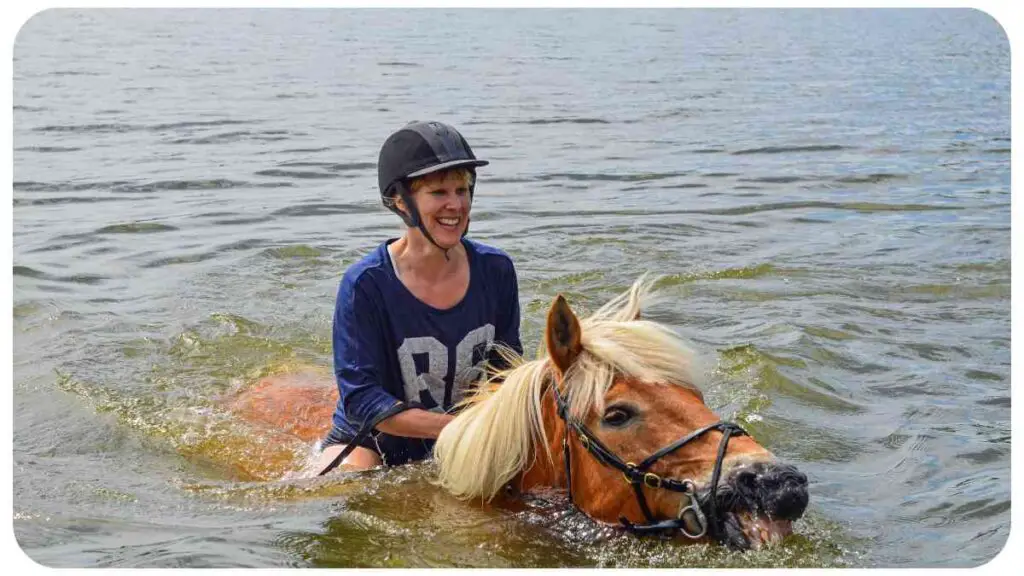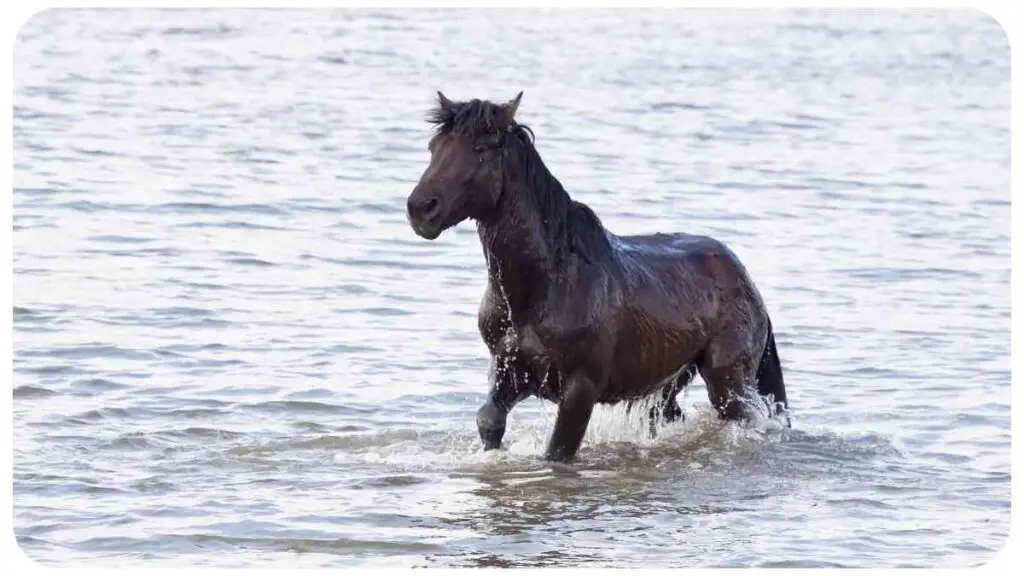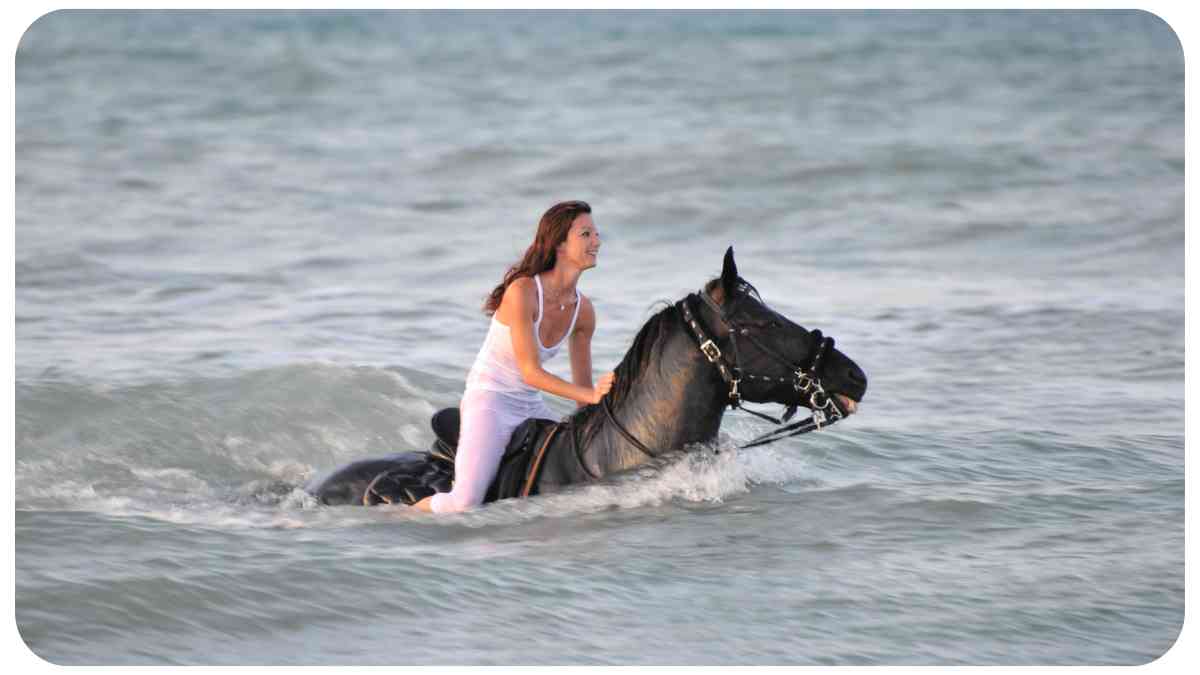If you’ve ever wondered whether horses can swim, you’ve come to the right place. In this article, we will delve into the world of horse swimming and explore the various aspects related to this intriguing topic. As a professional with experience and expertise in horse swimming, I aim to provide you with a comprehensive guide that incorporates my personal insights, tips, and anecdotes.
| Key Points |
| Horse swimming offers various physical and mental benefits. |
| Swim training programs should be tailored to individual horses. |
| Safety precautions such as supervision and safety gear are vital. |
| Gradual introduction can help horses overcome fear of water. |
| Swimming can be beneficial for horses with joint issues. |
Understanding the Basics of Horse Swimming
Horse swimming is the act of deliberately bringing a horse into contact with water, allowing it to move through and across it using natural swimming motions. While horses are not natural swimmers like dolphins or fish, they possess the ability to stay afloat and propel themselves in water. Understanding the intricacies of horse swimming involves examining the anatomy and technique behind their movements.
When it comes to horse riding, mastering proper riding techniques is crucial for ensuring safety and avoiding accidents. Understanding how to maintain balance, use correct posture, and communicate effectively with your horse can make all the difference in your riding experience.
How Horses Swim: Anatomy and Technique
Horses rely on their powerful musculature to paddle their way through water. Their large, muscular hindquarters are especially useful in generating the necessary thrust for propulsion. Additionally, their long legs allow them to kick and create forward motion. Table: Muscles Used in Horse Swimming provides a breakdown of the main muscles utilized during swimming.
| Muscles Used in Horse Swimming |
| Pectoral Muscles |
| Quadriceps |
| Hamstrings |
| Gluteus Muscles |
| Abdominal Muscles |
| Trapezius Muscles |
By understanding the horse’s anatomy, trainers and owners can better appreciate the unique challenges and requirements involved in swim training.
Muscles Used in Horse Swimming

| Muscles Used in Horse Swimming |
| Pectoral Muscles |
| Quadriceps |
| Hamstrings |
| Gluteus Muscles |
| Abdominal Muscles |
| Trapezius Muscles |
Swim Training for Horses
Swim training plays a crucial role in ensuring horses are comfortable and proficient in water. Various methods can be employed to train horses for swimming, including the use of water treadmills, swimming pools, and natural water bodies.
Water Treadmill
Water treadmills are exceptional tools for conditioning and therapy. They allow controlled swimming in a confined space, making them suitable for horses recovering from injuries or those in need of low-impact exercise. The table below highlights the advantages of using water treadmills for horse swim training.
| Advantages of Water Treadmills for Horse Swim Training |
| Controlled Environment |
| Low-Impact Exercise |
| Adjustable Water Depth and Speed |
| Rehabilitation Possibilities |
Advantages of Water Treadmills for Horse Swim Training
| Advantages of Water Treadmills for Horse Swim Training |
| Controlled Environment |
| Low-Impact Exercise |
| Adjustable Water Depth and Speed |
| Rehabilitation Possibilities |
Swimming Pools and Natural Water Bodies
Swimming pools and natural water bodies such as lakes, ponds, or rivers provide a more open swimming experience for horses. These environments allow horses to practice their swimming skills and build endurance. However, it is essential to ensure the safety and suitability of the chosen location. Refer to Table: Factors to Consider when Choosing a Swimming Location for Horses for guidance.
Equine colic is a serious condition that every horse owner should be aware of. By understanding and preventing equine colic, you can take important steps to minimize the risks and keep your horse healthy. Learn about common causes, signs to watch out for, and preventive measures.
| Factors to Consider when Choosing a Swimming Location for Horses |
| Water Depth |
| Water Quality |
| Access Points and Ramps |
| Containment and Safety Measures |
Factors to Consider when Choosing a Swimming Location for Horses
| Factors to Consider when Choosing a Swimming Location for Horses |
| Water Depth |
| Water Quality |
| Access Points and Ramps |
| Containment and Safety Measures |
Types of Swim Training Sessions
Swim training sessions vary depending on the desired goals and needs of the horse. Here are three common types of swim training sessions:
- Conditioning Sessions: These sessions focus on improving the horse’s cardiovascular fitness and muscle strength. The duration and intensity of the swim are gradually increased over time to build endurance.
- Rehabilitation Sessions: Horses recovering from injuries can benefit greatly from swim therapy. The buoyancy of the water reduces impact on joints and tissues, allowing for gentle exercise and promoting healing.
- Cross-Training Sessions: Incorporating swim training into a horse’s overall fitness program can provide a healthy balance and prevent repetitive strain injuries. By alternating between traditional land-based exercises and swim sessions, horses can strengthen different muscle groups and enhance overall performance.
It’s important to consult with a professional trainer or veterinarian to determine the appropriate swim training program for your horse, taking into consideration its fitness level, health, and specific needs.
Benefits of Horse Swimming
Horse swimming offers a range of benefits, both physical and mental, for these majestic creatures. Let’s explore some of the advantages that come with incorporating swim training into a horse’s routine.
Physical Fitness and Conditioning
Swimming engages a horse’s entire body, providing a low-impact cardiovascular workout. It helps build muscle strength, endurance, and overall fitness. The resistance of the water adds an extra challenge, making swimming a great way to condition horses for various activities such as racing, jumping, or endurance events.
Rehabilitation and Injury Prevention
As mentioned earlier, swim therapy serves as an effective rehabilitation tool for horses recovering from injuries. The buoyancy of the water reduces stress on injured joints and limbs, allowing for controlled movement and gentle exercise. Moreover, swimming can aid in preventing future injuries by improving flexibility, maintaining joint health, and strengthening muscles.
Muscular Development and Strengthening
Horse swimming targets specific muscle groups, including the pectoral muscles, quadriceps, hamstrings, gluteus muscles, abdominal muscles, and trapezius muscles. Through regular swim training, these muscles are strengthened, contributing to improved performance and reduced risk of strain or injuries.
Knowing how much exercise your horse needs is essential for maintaining their fitness and overall well-being. Understanding fitness needs ensures that you provide appropriate physical activity and mental stimulation to keep your horse happy and in optimal condition.
Mental Stimulation and Relaxation
Swimming provides mental stimulation and relaxation for horses. It introduces a new and exciting element to their routine, breaking the monotony of regular land-based exercises. Moreover, the water itself has a calming effect on many horses, promoting relaxation and reducing stress.
Table: Notable Horse Swimming Achievements
| Horse | Achievement |
| Secretariat | Swam across a river during a race |
| Seabiscuit | Engaged in regular swim training sessions |
| Black Caviar | Developed a deep love for water and swimming |
| American Pharoah | Enjoyed swimming as part of post-race recovery |
Safety Considerations for Horse Swimming
As with any activity involving animals, safety should always be a top priority when it comes to horse swimming. Here are some key considerations to ensure the well-being of both horse and rider:
Choosing the Right Location
When selecting a swimming location, consider factors such as water depth, quality, accessibility for horses, and the presence of ramps or access points. It’s crucial to choose a location that is safe, clean, and appropriate for your horse’s swimming abilities.
Supervision and Safety Gear
Always have a trained professional present during horse swimming sessions. They can monitor the horse’s behavior, provide guidance, and ensure safety protocols are followed. Additionally, using safety gear like flotation devices or life jackets can provide an extra layer of protection, especially for less experienced swimmers.
Proper Warm-up and Cool-down Procedures

Just like any exercise routine, horses should undergo proper warm-up and cool-down procedures before and after swimming sessions. This helps prepare their muscles, joints, and cardiovascular system for the activity and aids in preventing injuries or muscle soreness.
Monitoring Water Conditions
Regularly check the water conditions, including temperature, clarity, and any potential hazards. Horses should swim in clean, properly maintained water that is free from toxins or contaminants.
By adhering to these safety guidelines, you can ensure a safe and enjoyable swimming experience for both you and your horse.
Stay tuned for the next section where we’ll address some frequently asked questions about horse swimming!
Horse allergies can cause a range of problems, from respiratory issues to skin irritations. By understanding what horse allergies mean and how to manage them, you can take proactive measures to identify triggers, implement proper care, and provide relief for your horse’s allergies.
Frequently Asked Questions (FAQs)
In this section, we will address some common questions and provide answers that will further enhance your understanding of horse swimming.
Table: Common Questions about Horse Swimming
| Question | Answer |
| Are all horse breeds capable of swimming? | Most horse breeds are capable of swimming to some extent. However, certain factors, such as conformation, natural buoyancy, and temperament, can influence their swimming ability. While some horses may swim effortlessly, others may require more training and practice to become comfortable swimmers. |
| How can I introduce my horse to swimming? | Introducing your horse to swimming should be done gradually and with patience. Start with shallow water and allow your horse to get accustomed to the sensation. Use positive reinforcement and praise to build confidence. It’s helpful to have an experienced equestrian or trainer present during the initial stages to ensure a smooth transition. |
| Can swimming help with a horse’s fear of water? | Yes, swimming can be an effective way to overcome a horse’s fear of water. By gradually exposing the horse to water and offering positive experiences, you can help them build trust and confidence. It’s important to proceed at their pace and not force them into uncomfortable situations. With time and patience, many horses can overcome their fear and even develop a love for swimming. |
| Is it safe to swim with a horse? | Swimming with a horse can be an enjoyable experience, but it requires proper training, supervision, and safety measures. Only experienced riders and swimmers should attempt this activity, and it is recommended to do so in controlled environments like swimming pools designed for horse interaction. Safety gear, such as life jackets, should be used for added precaution. |
| Can swimming benefit horses with joint issues? | Yes, swimming can be beneficial for horses with joint issues, as the buoyancy of the water reduces stress on the joints while providing a low-impact form of exercise. However, it’s important to consult with a veterinarian or equine specialist to determine the suitability and appropriate training protocols for each individual horse. |
Conclusion
In conclusion, horse swimming is an intriguing activity that offers numerous benefits for horses, both physically and mentally. Understanding the anatomy and technique behind horse swimming is essential for effective swim training. Water treadmills, swimming pools, and natural water bodies provide different options for horse swim training, each with its own advantages.
By incorporating swim training into a horse’s routine, owners and trainers can enhance their horse’s physical fitness, aid in rehabilitation, promote muscular development, and provide mental stimulation. However, it is important to prioritize safety at all times by choosing the right location, having proper supervision, using safety gear, and following warm-up and cool-down procedures.
Throughout this article, we have explored the various aspects of horse swimming, providing insights, tips, and anecdotes from my own experiences as a professional in the field. Remember that each horse is unique, and it’s important to tailor swim training to their individual needs and abilities.
So, whether you’re considering introducing your horse to swimming for the first time or looking to implement swim training into your horse’s routine, I hope this article has provided you with valuable information and inspiration. Embrace the world of horse swimming, and enjoy the benefits it brings to you and your equine companion.
Happy swimming!
Proper saddle fitting is vital for both the comfort and performance of you and your horse. This guide on correct saddle fitting: pros, cons, and tips will help you understand the importance of proper saddle fit, explore different options, and ensure a harmonious riding experience for you and your equine partner
Further Reading
Here are some additional resources for further reading on the topic of horse swimming:
Can Horses Swim with a Rider?: This article explores the feasibility and safety of swimming with a rider on horseback, providing insights and considerations for this activity.
The Benefits of Horse Swimming: This resource delves into the various benefits that horse swimming can offer, including physical conditioning, rehabilitation, and mental stimulation.
Swim Training Techniques for Horses: This article provides practical tips and techniques for swim training horses, covering topics such as introducing horses to water, safety considerations, and different swim training methods.
FAQs
Here are some frequently asked questions about horse swimming:
Can horses of all breeds swim?
Most horses can swim to some extent, but certain factors, such as conformation and temperament, may affect their swimming ability.
How can I introduce my horse to swimming?
To introduce your horse to swimming, start in shallow water and gradually build up their comfort and confidence. Positive reinforcement and patience are key during the introduction process.
Can swimming benefit horses with joint issues?
Yes, swimming can benefit horses with joint issues as the buoyancy of the water reduces stress on their joints while providing low-impact exercise. Consult with a veterinarian for tailored advice.
Is it safe to swim with a horse?
Swimming with a horse can be an enjoyable experience, but it requires proper training, supervision, and safety measures. Only experienced riders and swimmers should attempt this, with safety gear precautions.
How can swimming help with a horse’s fear of water?
Gradually exposing horses to water and offering positive experiences can help overcome their fear. Patience, building trust, and proceeding at their pace are essential for helping horses become comfortable with water.

Hi there! My name is Hellen James, and I’m a horse riding expert. I’ve been riding horses since I was just a kid—and it’s been my passion ever since. But getting started with horse riding can be overwhelming. There’s so much to learn! If you’re looking for a way to get started and make sure you’re doing it right, I’m here to help.


